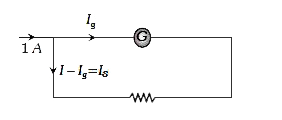A galvanometer having a resistance of 8 ohm is shunted by a wire of resistance 2 ohm . If the total current is 1 amp , the part of it passing through the shunt will be
0.25 amp
0.8 amp
0.2 amp
0.5 amp
The correct Answer is:B

Is=(82+8)1=810=0.8A
Topper's Solved these Questions
- CURRENT ELECTRICITYBOOK - ERRORLESSCHAPTER - CURRENT ELECTRICITYEXERCISE - NCERT BASED QUESTIONS (HEATING EFFECT OF CURRENT)
67 Videos
- CURRENT ELECTRICITYBOOK - ERRORLESSCHAPTER - CURRENT ELECTRICITYEXERCISE - PAST YEARS QUESTIONS
76 Videos
- CURRENT ELECTRICITYBOOK - ERRORLESSCHAPTER - CURRENT ELECTRICITYEXERCISE - NCERT BASED QUESTIONS (KIRCHHOFF.S LAW, CELLS)
53 Videos
- ATOMIC AND NUCLEAR PHYSICSBOOK - ERRORLESSCHAPTER - ATOMIC AND NUCLEAR PHYSICSEXERCISE - Assertion and Reason
23 Videos
- ELECTROMAGNETIC INDUCTIONBOOK - ERRORLESSCHAPTER - ELECTROMAGNETIC INDUCTIONEXERCISE - ASSERTION & REASON
20 Videos
Similar Questions
A galvanomter of resistance 50Ω is shunted by a resistance of 5Ω. What fraction of the main current passes through the galvanometer? Through the shunt?
View SolutionA galvanometer is shunted by 1/n th of its resistance. Find the fraction of the total current passing through the galvanometer.
View Solution
Knowledge Check
A galvanometer having a resistance of 8 ohm is shunted by a wire of resistance 2 ohm . If the total current is 1 amp , the part of it passing through the shunt will be
A0.25 AB0.8 AC0.2 AD0.5 AA galvanometer having a resistance of18Ωis shunted by a wire of resistance 2Ω. If the total current to be passed is 2A, then the part of it passing through the shunt will be
A0.8AB1.5AC1.8AD1.25AA galvanometer of resistance 98 ohms is shunted by a resistance of 2 ohms. The fraction of the total current that pass through is.
A1/50B1/49C1/2D1/98
When a galvanometer of resistance G is shunted with a low resistance S, then the effective resistance Reff of galvanometer becomes
Reff=GSG+S
If current is passed through such a galvanometer, then the major amount of current flows through shunt and the rest through galvanometer, i.e., the current divides itself in the inverse ratio of resistance.
Read the above passage and answer the following questions:
(i) Why is the resistance of shunted galvanometer lower than that of shunt?
(ii) A galvanometer of resistance 30Ω is shunted by a resistance of 3Ω. What fraction of the main current passes (i) through the galvanometer and (ii) through the shunt?
(iii) What are the basic values you learn from the above study?
View SolutionA galvanometer has a resistance of 98Ω .it is shunted by 2Ω resistance. The fraction of the total current passing through the galvanometer is
View SolutionA galvanometer of resistance 90 Ω is shunted by a resistance of 10 Ω. What fraction of main current passes through the shunt ?
View SolutionA galvanometer of resistance G is shunted by a resistance Sohm. To keep the main current in the circuit uncharged, the resistnace to be put in series with the galvonmeter
View SolutionA galvanometer of resistance, G, is shunted by a resistance S ohm. To keep the main current in the circuit unchanged, the resistance to be put in series with the galvanometer is
View Solution
